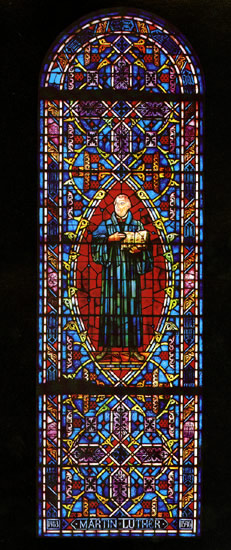
Martin Luther was born in Eisleben in Prussian Saxony. His parents were poor, but honest and industrious people. As a youth, Luther was subjected to strict discipline and taught to pray to God and the saints and to revere the church and its priests.
He studied scholastic philosophy at the University of Erfurt and became especially interested in the ancient classics. His ability as a student was indicated by the fact he passed the master’s examination in the winter of 1505, ranking second in a list of 17. He began to study law but soon turned to theology.
A sincere monk at Erfurt, Luther studied diligently and was ordained to the priesthood in the second year of his monastic life. During a visit to Rome in 1511 he became convinced of the “great truth of justification by faith” and began his preaching career. He was transferred to Wittenberg in 1511 and appointed sub-prior of the cathedral in the city. Upon receiving his doctorate degree in theology, Luther became a professor of biblical literature at the university and thus held three positions of sub-prior, preacher, and professor.
During that time, he became engaged in controversy concerning the priesthood of the church and sought to bring about a reformation among the clergy. The effort soon led to complications through which Luther became the object of attack. It was in Wittenberg, at noon on Oct. 31, 1517, that he nailed the “95 Latin Theses” to the doors of the Castle Church. His action signaled the beginning of the Protestant Reformation.
Among his reform efforts, Luther enabled the masses to read the Bible for the first time by translating it into vernacular German. The reading of the Bible, however, necessitated a system of education whereby the people could learn to read, leading to the establishment of classes and schools. The era marked the formation of a new church which was later named after Luther.
He died on Feb. 18, 1546 in Eisleben. His funeral oration was delivered by Phillipp Melanchthon, one of the great minds of Luther’s day.
The left side border symbols of the Luther window, numbered from top to bottom, are: 1. a cross pattee fitched, a decorative form of the cross often used on altar cloths or other items of church furniture; 2. Martin Luther’s coat of arms representing the work of Luther in bringing the light of truth to the Germany of his day; and 3. the shield of St. Simon Zelotes, an appropriate symbol for the Luther window because of the Bible with a fish symbol. Luther made a translation of the Bible into German and insisted that his followers become acquainted with its contents. The fish represents the message, “Jesus Christ, Son of God, Savior.” The message is the result of reading the letters of the Greek word ichthus (‘fish’) as an acrostic:
The right side border symbols of the Luther window, numbered from top to bottom, are: 1. the symbol of Concordia, a Lutheran image, with the lyre representing Luther’s musical ability and the coat of arms associated with the house of Luther; 2. a lamp of knowledge representing the light of God’s knowledge brought to the world in Christ and the spreading of the light through the preaching of the reformer; and 3. the symbol of St. Martin applying to Luther because he was baptized on St. Martin’s Day, Nov. 11, 1483, and was named after the saint.














